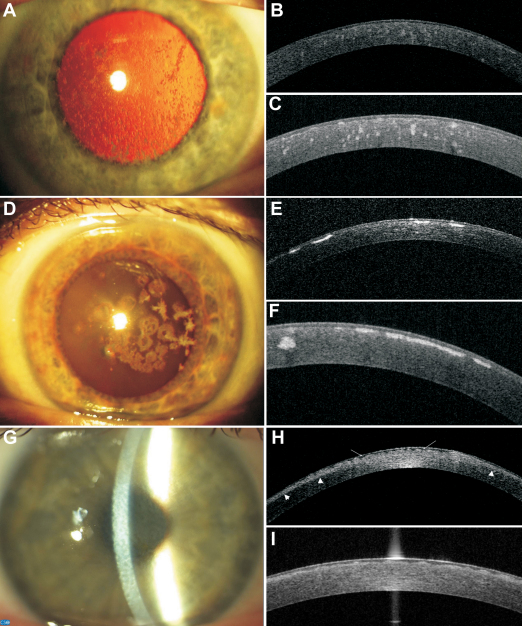Figure 1.
Representative images of slit-lamp photographs, 1310 nm time-domain and 1310 nm swept source spectral domain optical coherence tomography scans of patients with granular corneal dystrophy type I (family F4), granular corneal dystrophy type II (family F9), and Thiel-Behnke corneal dystrophy (family F8). A: Female patient (F4; 53 years). Slit-lamp photograph showing gray-white granular deposits located centrally, with clear intervening stroma. GCDI/ R555W mutation. B: Female patient (F4; 53 years). High-resolution corneal scan – 1310 nm time. domain OCT. Focal granular hyperreflective changes located at different depths within the corneal stroma. GCDI/ R555W mutation. C: Female patient (F4; 53 years). Radial scan-swept source 1310 nm spectral OCT. Focal granular hyperreflective changes located at different depths within the corneal stroma. The Bowman’s layer area shows a distinct irregularity. GCDI/ R555W mutation. D: Female patient (F9; 44 years). Slit-lamp photograph. Centrally located, multiform: star- and disc-shaped opacities. No lattice lines are visible, either on direct light nor on retroillumination. GCDII/ R124H mutation. E: Female patient (F9; 44 years). High-resolution corneal scan – 1310 nm time domain OCT. Highly reflective opacities with distinct borders located in the anterior corneal part. GCDII/ R124H mutation. F: Female patient (F9; 44 years). Radial scan-swept source 1310 nm spectral OCT. Highly reflective disc-shaped changes located in the anterior stroma, under the epithelium, involving Bowman’s layer. One hyperreflective granular opacity located deeper in the mid stroma. GCDII/ R124H mutation. G: Female patient (F8; 38 years). Slit-lamp photograph. Diffuse corneal changes showing reticular, “honeycomb” pattern located in the anterior corneal part. TBCD/ R555Q mutation. H: Female patient (F8; 38 years). High-resolution corneal scan – 1310 nm time domain OCT. The diffuse boarder of increased reflectivity in the anterior part of the cornea (arrowheads). In the Bowman’s layer area, there is a distinct irregularity due to corneal opacities (arrows). TBCD/ R555Q mutation. I: Female patient (F8; 38 years). Radial scan-swept source 1310 nm spectral OCT. Bowman’s layer is replaced by an irregular pattern of opacities. TBCD/R555Q mutation.

